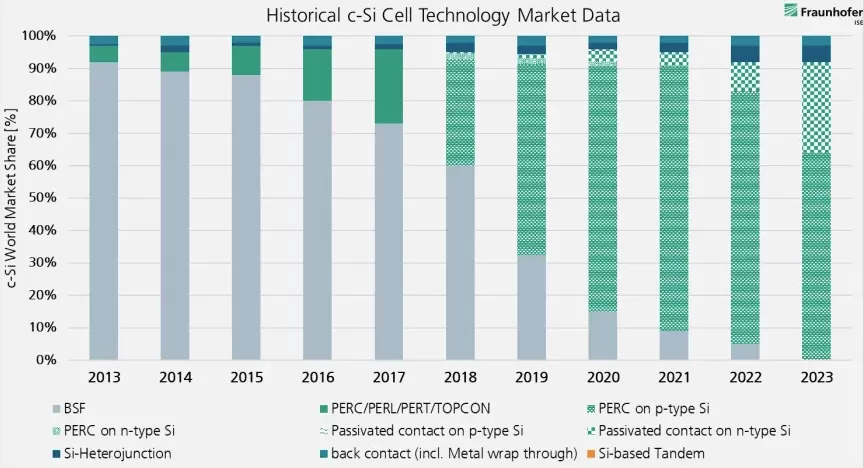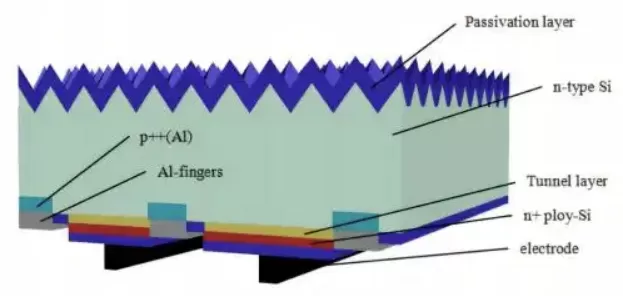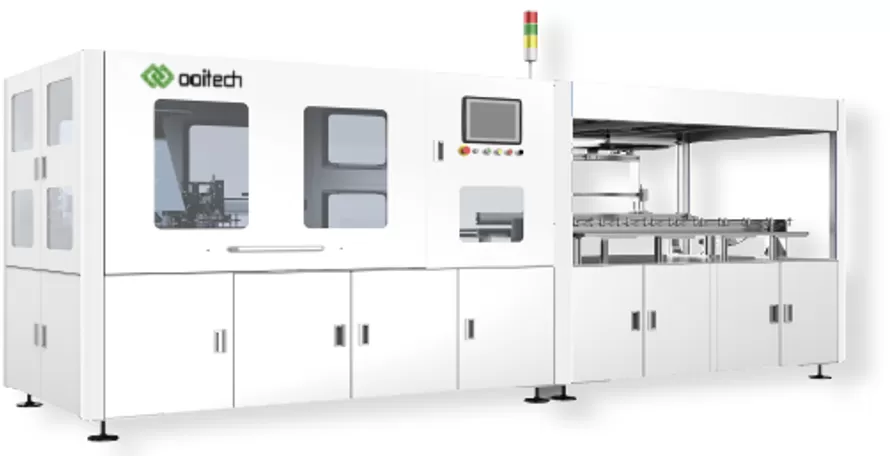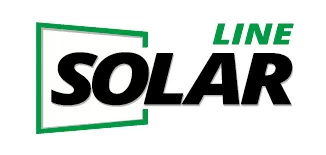How to Choose the Right BC Cell Stringer in 2025?
How to Choose the Right BC Cell Stringer in 2025? The Solar Technician's Guide
The future of solar energy is evolving rapidly, with BC (Back Contact) technology emerging as the game-changing innovation that promises to revolutionize how we harness the sun's power with unprecedented efficiency and aesthetic appeal.
By 2025, Back Contact solar cell technology will dominate the industry thanks to its significant efficiency advantages over traditional PERC cells, elimination of front-grid shadow loss, and superior aesthetic qualities through its innovative back-contact architecture that maximizes both performance and visual appeal.

A close-up view of Back Contact solar cell technology showing the absence of front gridlines
The transition to BC technology represents more than just an incremental improvement—it's a fundamental shift in how solar energy is captured and converted. As we examine this transformation, we'll explore why serious solar manufacturers need to adapt their production equipment and strategies now to remain competitive in the rapidly approaching BC-dominated landscape.
Why BC Technology Will Dominate by 2025?
Solar manufacturers worldwide are rapidly shifting focus toward BC technology as efficiency demands rise and production costs decrease, creating a perfect convergence of factors driving industry-wide adoption.
Back Contact solar technology will lead the market by 2025 because it delivers efficiency improvements of over 22% compared to conventional PERC cells, according to the latest NREL data[1]. This significant performance gain comes from eliminating front-side metallization that typically blocks 7-9% of incoming sunlight, allowing BC cells to capture more photons and generate substantially more electricity.

Comparative chart showing efficiency gains of BC technology over traditional PERC cells
1.1 The Efficiency Surge
The efficiency advantages of BC cells extend far beyond simply removing grid shadows. When examining how these cells function at the microscopic level, several technological breakthroughs become apparent.
Traditional solar cells suffer from what industry experts call the "gridline trade-off" – manufacturers must balance conductivity needs (requiring more metal coverage) against light absorption (requiring less metal coverage). Back Contact technology eliminates this compromise entirely by moving all metallization to the rear surface.
This architectural innovation allows for wider metallization patterns without sacrificing light absorption, resulting in lower resistive losses while maintaining maximum photon collection. In practical terms, this translates to modules that perform better in real-world conditions, especially during low-light periods when every photon matters[2].
The numbers tell a compelling story. In controlled testing environments across multiple manufacturers, BC cells consistently demonstrate conversion efficiencies of 24-26%, compared to PERC's typical 20-22% range. This 4% absolute efficiency gain represents approximately a 20% relative improvement – a massive jump in an industry where efficiency gains are typically measured in fractions of a percent year-over-year.
| Cell Technology | Average Efficiency | Annual Degradation Rate | Performance Ratio |
|---|---|---|---|
| PERC | 20-22% | 0.5-0.7% | 0.75-0.80 |
| BC (IBC) | 24-26% | 0.3-0.5% | 0.82-0.86 |
| BC (HPBC) | 25-27% | 0.2-0.4% | 0.84-0.88 |
1.2 Aesthetic and Functional Gains
Beyond pure efficiency metrics, BC technology delivers substantial aesthetic benefits that are increasingly important in consumer and commercial applications.
The elimination of front-side metallization creates solar panels with a uniform, all-black appearance that architects and property owners strongly prefer. This aesthetic improvement eliminates the "checkerboard" look of conventional panels, allowing for more seamless integration with building designs[3].
Several high-profile architectural projects have already demonstrated the superior visual appeal of BC modules. The award-winning Amsterdam Edge Olympic building integrated 484 custom-sized BC modules that not only generate clean energy but enhance the building's modern aesthetic. Similarly, luxury residential developments are increasingly specifying BC panels for their premium appearance, creating a market segment where both performance and aesthetics command premium pricing.
The functional benefits extend to improved low-light and high-temperature performance. With all conductors on the rear side, BC cells have more uniform temperature distribution, reducing hot spots and improving output during high-temperature conditions – a critical factor in maintaining energy production during summer months when solar irradiance is highest but conventional panel output often suffers from heat-related efficiency losses.
Current BC Cell Variants Shaping the Market
The Back Contact solar cell market features several distinctive technologies, each offering unique advantages that cater to different applications and manufacturing capabilities.
Today's BC cell market features three primary variants: IBC (Interdigitated Back Contact), HPBC (Hybrid Passivated Back Contact), and ABC (All Back Contact), each optimized for specific performance characteristics. While IBC cells achieve 25.6% efficiency using full back electrodes, HPBC leads with 26.1% efficiency through hybrid passivation technology, and ABC cells reach 25.8% efficiency by implementing atomic layer deposition techniques[4].

Side-by-side comparison of IBC, HPBC, and ABC cell architectures showing structural differences
2.1 Diving into BC Cell Variants
Each Back Contact cell variant represents a different approach to the fundamental concept of moving all electrical contacts to the rear side of the cell. The technical distinctions between these variants directly impact manufacturing requirements and final module performance.
IBC (Interdigitated Back Contact) technology features alternating p-type and n-type regions on the cell's rear surface, with interdigitated finger electrodes collecting generated electrons and holes. This architecture, pioneered by SunPower (now Maxeon Solar Technologies), requires sophisticated patterning processes but achieves exceptional uniformity. IBC cells typically incorporate advanced passivation layers that minimize recombination losses, a critical factor in their high efficiency[5].
The manufacturing process for IBC cells demands precision alignment during the metallization stage, as even minor misalignments between the interdigitated fingers can significantly impact performance. This technical challenge has historically limited widespread adoption despite the technology's efficiency advantages.
HPBC (Hybrid Passivated Back Contact) cells represent an evolution that combines elements of traditional cell architecture with back contact concepts. The "hybrid" designation refers to the passivation approach, which utilizes different materials and techniques for the front and rear surfaces. This specialized passivation strategy reduces surface recombination to exceptionally low levels, enabling the 26.1% efficiency that leads the commercial market.
HPBC technology has gained significant traction because its manufacturing process can partially leverage existing production equipment, offering a transition path for manufacturers hesitant to completely overhaul their production lines. The technology also demonstrates superior temperature coefficients, maintaining higher output at elevated operating temperatures.
| Technology Attribute | IBC | HPBC | ABC |
|---|---|---|---|
| Manufacturing Complexity | High | Medium | Medium-High |
| Materials Cost | High | Medium-High | Medium |
| Equipment Compatibility | Low | Medium | Low-Medium |
| Bifaciality Potential | None | Low | Medium |
| Temperature Coefficient | -0.29%/°C | -0.26%/°C | -0.28%/°C |
ABC (All Back Contact) technology, the newest variant, utilizes atomic layer deposition to create ultra-thin, highly conformal layers that maximize efficiency while potentially reducing manufacturing costs. The atomic-level precision of this approach enables tighter control over material properties, resulting in cells with exceptional uniformity and performance consistency[6].
The defining characteristic of ABC technology is its simplified architecture compared to IBC, which reduces the number of processing steps while maintaining comparable efficiency. This streamlined manufacturing approach has attracted significant interest from producers looking to balance performance with production economics.
The Hidden Challenges of BC Cell Welding
Manufacturing high-performance BC modules requires overcoming complex welding challenges that can impact both immediate productivity and long-term reliability in the field.
The welding process for BC cells presents unique challenges that must be addressed to maintain cell integrity and performance. Achieving non-destructive alignment with tolerances below 50μm, implementing low-stress welding techniques for thin 120μm N-type wafers, and utilizing infrared verification for real-time monitoring are all critical factors for successful backside bonding of BC cells[7].

High-precision welding equipment designed specifically for Back Contact solar cells
3.1 Critical Factors in Backside Bonding
The backside bonding process for BC cells represents one of the most technically demanding aspects of module assembly, requiring specialized equipment and precise control systems.
The first critical challenge is non-destructive alignment with tolerances below 50μm. This microscopic precision is necessary because BC cells feature densely patterned contact points that must align perfectly with the interconnection materials. Unlike conventional cells where alignment tolerances of 1-2mm are acceptable, BC cells require positional accuracy comparable to semiconductor manufacturing.
Modern stringers designed for BC cells employ advanced vision systems with real-time feedback loops that can detect and correct position errors before contact is made. These systems typically use multiple high-resolution cameras working in concert with precision motion controllers to achieve the required alignment accuracy. Without this level of precision, connection quality suffers and module efficiency declines.
The second major consideration is implementing low-stress welding techniques appropriate for the thin 120μm N-type wafers typically used in BC cell production. These wafers are approximately 40% thinner than conventional cells, making them particularly vulnerable to mechanical stress during the welding process.
| Welding Parameter | Conventional Cells | BC Cells | Reason for Difference |
|---|---|---|---|
| Welding Temperature | 220-260°C | 180-220°C | Thinner wafers require lower temps |
| Pressure Applied | 1.5-3.0 N | 0.5-1.5 N | Reduced stress on fragile wafers |
| Contact Time | 2-3 seconds | 1-2 seconds | Minimized thermal exposure |
| Heat Ramp Rate | 50-80°C/sec | 30-50°C/sec | Gentle thermal gradient |
| Cooling Method | Natural | Controlled | Prevents thermal shock |
Leading manufacturers have developed specialized welding heads that distribute pressure evenly while applying precisely controlled heat. Some advanced systems utilize pulsed energy delivery that minimizes the total thermal energy transferred to the cell while still achieving proper metallurgical bonding. These technical refinements significantly reduce the occurrence of microcracks that might not be immediately apparent but can lead to power degradation over time[8].
The third essential element is infrared verification systems that provide real-time feedback on connection quality. These systems use thermographic imaging to detect temperature anomalies that indicate potential connection problems. By monitoring the thermal signature during and immediately after welding, operators can identify issues before cells progress to the lamination stage, where problems become much more costly to resolve.
3.2 Red Flags in BC Welding Quality
Identifying quality issues early in the production process is essential for maintaining high yields and ensuring long-term module reliability.
Two critical indicators serve as early warning signs for welding quality issues in BC module production:
Visible infrared hotspots during EL testing reveal uneven current flow caused by inconsistent connection quality. Modern EL testing equipment specifically configured for BC modules can detect subtle variations in electrical continuity that might escape visual inspection. Advanced systems incorporate AI-based image processing that flags anomalies based on comparison with known good patterns, enabling automated quality control even at high production volumes[9].
Power degradation exceeding 0.2% after Thermal Cycling tests (per IEC 61215 standards) indicates inadequate welding quality or material fatigue. This standardized test subjects modules to temperature extremes ranging from -40°C to +85°C for 200 complete cycles, simulating years of environmental stress in an accelerated timeframe.
Manufacturers implementing comprehensive quality monitoring programs typically perform both inline testing during production and batch sampling for more intensive reliability verification. This multi-layered approach helps identify both process drift that might affect large numbers of modules and random defects that could impact individual units.
How Premium Stringers Boost BC Module Performance?
Investing in advanced stringer technology yields measurable improvements in BC module quality, production efficiency, and long-term reliability that directly impact financial returns.
Premium stringers designed specifically for BC cell assembly deliver significant performance advantages, including 0.15% higher yield through advanced tension control systems that prevent cell warping, 30% faster production with multi-track systems processing up to 3,800 cells per hour, and zero grid-line ghosting through precision laser ablation that ensures clean interconnects[10].

Multi-track BC cell stringer demonstrating high-throughput production capabilities
4.1 High Yield and Speed
The economic viability of BC module production depends heavily on maximizing both yield and throughput, areas where premium stringers provide measurable advantages.
Advanced tension control systems prevent cell warping during the interconnection process, a particularly critical factor for the thinner wafers used in BC cell production. These systems continuously monitor and adjust tension parameters based on real-time feedback, maintaining optimal pressure regardless of minor variations in cell thickness or ambient conditions.
This precise tension management results in a 0.15% higher yield compared to standard equipment – a seemingly small percentage that translates to significant economic value at production scale. For a 1GW production line, this yield improvement represents approximately 1.5MW of additional annual capacity without any increase in raw material consumption.
| Production Parameter | Standard Stringer | Premium BC Stringer | Improvement |
|---|---|---|---|
| Hourly Throughput | 2,900 cells/hour | 3,800 cells/hour | +31% |
| Yield Rate | 98.8% | 99.3% | +0.5% |
| Downtime | 5-7% | 2-3% | -60% |
| Defect Rate | 0.3-0.5% | 0.1-0.2% | -66% |
| Labor Requirement | 3-4 operators | 1-2 operators | -50% |
Multi-track systems capable of processing 3,800 cells per hour represent another significant advantage of premium stringers. These high-throughput systems incorporate parallel processing capabilities with independent track control, allowing simultaneous handling of multiple strings while maintaining precise alignment and welding parameters for each cell.
The productivity gains from these advanced systems extend beyond raw throughput numbers. Higher processing speeds reduce work-in-progress inventory, decrease manufacturing lead times, and improve capital utilization – all factors that contribute to improved return on investment for manufacturing operations.
4.2 Cleaner Interconnects
The quality of interconnections directly impacts both immediate performance and long-term reliability of BC modules, making this a critical differentiator for premium stringer equipment.
Precision laser ablation technology ensures zero grid-line ghosting – a visual and performance defect caused by improper interconnect formation. This technology uses finely controlled laser pulses to prepare connection surfaces with microscopic precision, creating optimal conditions for metallurgical bonding without damaging the surrounding cell structure.
The resulting clean interconnects provide several technical advantages:
Lower contact resistance, resulting in reduced power losses
Improved mechanical strength that enhances durability during temperature cycling
More consistent electrical characteristics across the module
Reduced potential for electrochemical corrosion over time
These improvements in interconnect quality contribute directly to module performance metrics including fill factor, series resistance, and degradation rates. Modules produced with premium stringers typically demonstrate 0.5-1.0% higher power output immediately after production and maintain their performance advantage throughout their operational lifetime.
The Next-Gen Stringer Checklist for Manufacturers
Selecting appropriate stringer technology requires evaluating multiple technical criteria that directly impact production capabilities and finished module quality.
Manufacturers preparing for the BC cell transition should prioritize equipment with multi-mode compatibility supporting MBB/0BB/BC technologies, AI-powered defect detection systems achieving ≥98% accuracy through Convolutional Neural Networks, and designs that ensure low failure rates (≤10ppm) in damp heat testing under conditions of 85°C/85% relative humidity[1].

Advanced AI-powered control system interface for next-generation BC cell stringers
5.1 Future-Proofing with Technology
As the solar manufacturing landscape continues to evolve rapidly, investing in flexible, adaptable equipment has become essential for sustainable business operations.
The first critical requirement is MBB/0BB/BC multi-mode compatibility that allows manufacturers to produce various module types without major equipment changes. This flexibility is particularly valuable during the transition period when many manufacturers will be producing both conventional and BC modules simultaneously.
Advanced stringers achieve this multi-mode capability through modular design approaches with interchangeable tooling sets and software-controlled parameter adjustments. Rather than requiring complete production line replacements, these systems allow incremental adaptation as technology and market demands evolve.
| Compatibility Feature | Implementation Method | Benefits |
|---|---|---|
| Adjustable alignment systems | Computer vision with adaptive algorithms | Accommodates different cell architectures |
| Variable pressure control | Electronic force sensors with feedback loops | Optimizes welding parameters for each cell type |
| Configurable transport systems | Modular conveyor designs with quick-change components | Handles various cell dimensions and weights |
| Software-defined process control | Cloud-connected parameter libraries | Enables rapid process updates and optimization |
| Universal welding head design | Multi-function tools with selectable modes | Eliminates tooling changeover time |
The second essential feature is AI-powered defect detection using advanced computer vision and Convolutional Neural Networks (CNNs) that achieve ≥98% accuracy in identifying defects. These systems continuously improve through machine learning, building comprehensive defect libraries that enable detection of even subtle quality issues.
Modern AI systems go beyond simple pass/fail inspection by classifying defects into categories, identifying process drift before it results in significant yield loss, and providing actionable feedback for process improvement. The most advanced systems now incorporate predictive capabilities that anticipate potential quality issues based on subtle pattern recognition beyond human visual capacity[2].
The third critical specification is demonstrating low failure rates in damp heat testing, maintaining ≤10ppm failure rates under conditions of 85°C/85% relative humidity. This stringent environmental testing simulates accelerated aging in harsh conditions and provides a reliable indicator of long-term field performance.
Equipment designed to produce modules that meet this standard typically incorporates features such as:
Precision temperature profiling during the welding process
Automated process verification at multiple production stages
Materials handling systems that prevent contamination
Connection quality validation through electrical performance testing
These technical capabilities collectively ensure that the finished modules will maintain their performance characteristics even when exposed to challenging environmental conditions throughout their 25+ year expected operational lifetime.
Future-Ready Solutions Emerging in 2024
The next wave of stringer technology is already taking shape, with innovations focused on automation, precision, and integrated intelligence that will redefine production standards.
Leading manufacturers are now introducing next-generation stringers featuring closed-loop temperature control with ±1°C precision for Ag-coated Cu ribbons, self-calibrating vision systems achieving micron-level alignment, and IoT-enabled predictive maintenance capabilities that proactively monitor system health to prevent production disruptions[3].

IoT-enabled smart stringer with predictive maintenance capabilities and cloud connectivity
6.1 Key Innovations
The stringer technologies emerging in 2024 incorporate several groundbreaking innovations that address longstanding production challenges while introducing new capabilities.
Closed-loop temperature control systems with ±1°C precision represent a significant advancement for handling Ag-coated Cu ribbons, which require highly specific thermal profiles to achieve optimal metallurgical bonding without damaging the coating or substrate. These systems utilize multiple distributed temperature sensors and rapid-response heating elements to maintain precisely defined thermal conditions throughout the welding process.
The importance of this precise temperature control becomes particularly evident when working with advanced interconnect materials that feature increasingly thin silver coatings (often<5μm) on copper substrates. The narrow process window for these materials demands exceptional thermal stability to maintain consistent bond quality while minimizing silver consumption – a significant factor in module cost optimization.
| Temperature Control Parameter | Current Technology | 2024 Technology | Improvement Impact |
|---|---|---|---|
| Control Precision | ±3-5°C | ±1°C | Consistent bond quality |
| Response Time | 500-800ms | 150-200ms | Prevents temperature excursions |
| Measurement Points | 2-4 points | 8-12 points | Eliminates thermal gradients |
| Calibration Frequency | Weekly | Self-calibrating | Prevents drift-related issues |
| Energy Consumption | Baseline | 30-40% reduction | Lower operating costs |
Self-calibrating vision systems capable of micron-level alignment represent another significant technological leap. These systems combine high-resolution imaging with automated calibration routines that compensate for mechanical wear, thermal expansion, and other factors that might affect positioning accuracy over time.
Unlike conventional systems that require manual calibration by skilled technicians, self-calibrating systems perform continuous in-process verification and adjustment, maintaining optimal alignment without production interruptions. This capability is particularly valuable for BC cell production, where alignment requirements are significantly more demanding than for conventional cells[4].
Perhaps most transformative is the integration of IoT-enabled predictive maintenance capabilities that continuously monitor system health across hundreds of parameters. These intelligent systems analyze performance patterns to identify potential issues before they cause production disruptions, dramatically reducing unplanned downtime.
Advanced implementations incorporate digital twin technology that maintains a virtual model of the physical equipment, allowing simulation and optimization of maintenance activities. Some systems now offer manufacturer-connected remote monitoring that provides specialized technical support based on real-time performance data, effectively creating a partnership between equipment suppliers and users to maximize productivity.
The integration of these technologies creates production equipment that not only delivers superior technical performance but also contributes to operational excellence through improved reliability, reduced maintenance costs, and enhanced process control. For manufacturers entering the BC module market, these advanced capabilities provide significant competitive advantages in both production economics and product quality.
In conclusion, the transition to BC cell technology represents both a challenge and an opportunity for solar manufacturers. By carefully selecting stringer equipment that addresses the unique requirements of BC cell processing while incorporating forward-looking capabilities, manufacturers can position themselves advantageously in this rapidly evolving market. The investment in premium stringer technology delivers returns through improved efficiency, higher throughput, and enhanced product quality—all factors that contribute directly to competitive success in the solar manufacturing industry.
For those interested in exploring the latest innovations in solar panel production technology, I invite you to visit our YouTube channel where we regularly share insights and demonstrations of advanced manufacturing equipment, including our MBB Full Automatic solar panel production line capabilities shown in this detailed video. At Ooitech, we're committed to supporting the industry's transition to higher-efficiency technologies through specialized equipment designed specifically for the unique requirements of advanced cell architectures.
References
[1]. International Technology Roadmap for Photovoltaics (ITRPV) 12th Edition 2021
[2]. NREL Best Research-Cell Efficiency Chart
[3]. Journal of Photovoltaics: Aesthetic Assessment of Building Integrated PV
[4]. Nature Energy: High-efficiency silicon heterojunction solar cells
[5]. SunPower Maxeon IBC Technology White Paper
[6]. Applied Materials: Atomic Layer Deposition in PV Manufacturing
[7]. Progress in Photovoltaics: Back-Contact Module Technology
[8]. Solar Energy Materials and Solar Cells: Microcrack formation in solar cells
[9]. IEEE Journal of Photovoltaics: AI-Based Defect Detection in PV Manufacturing
[10]. International Conference on Photovoltaic Science and Engineering Proceedings
Next:no more
